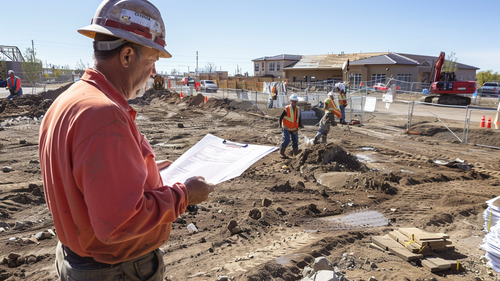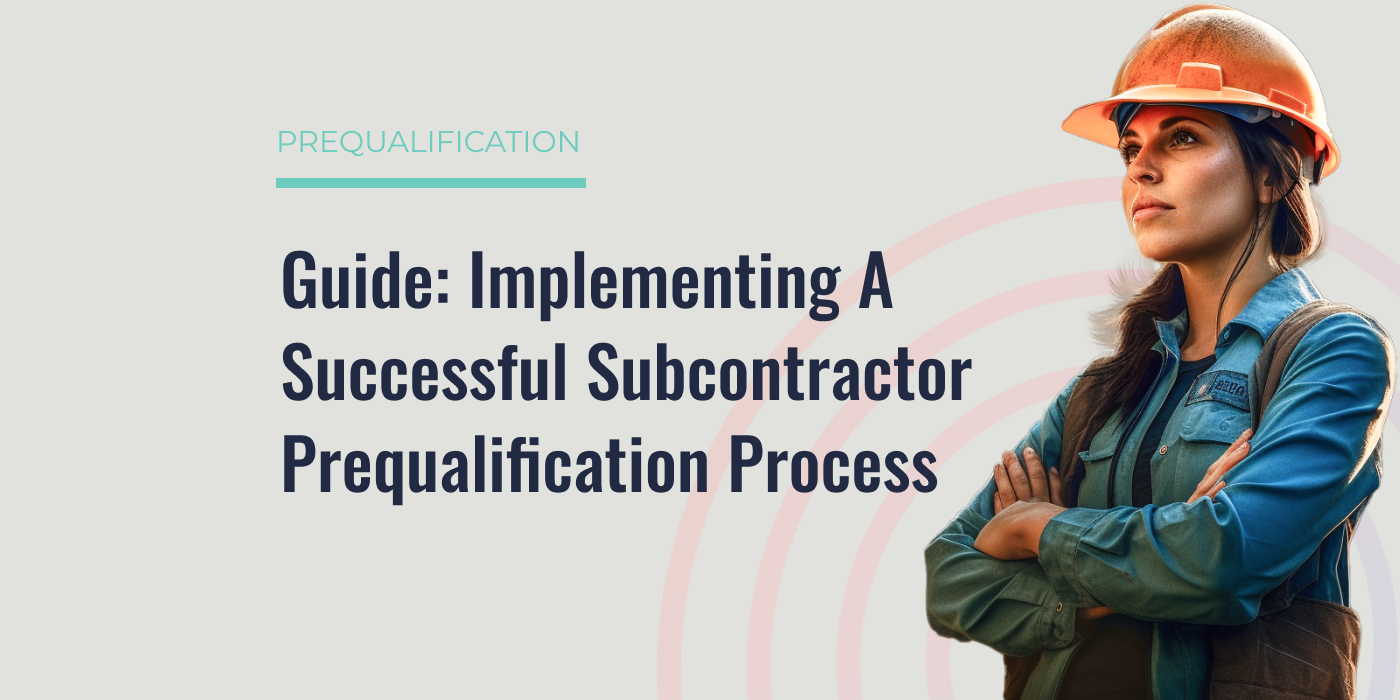Subcontractor Prequalification: A Vital Step in Construction Industry Success
Why do some construction endeavors seem to sail smoothly from idea to fruition, while others appear to be a constant uphill battle? The answer often...
13 min read
Jerad Ferrell
:
Apr 6, 2024 2:27:41 PM

In the complex world of construction, every detail counts, and every subcontractor plays a critical role in steering projects towards success. It’s not just about having the right solutions for the job; it’s about ensuring that everyone on your team, especially your subcontractors, is up to the task at hand. That’s where subcontractor prequalification steps into the spotlight – a crucial strategy that goes well beyond mere capability checks. This in-depth vetting process is all about digging deep into the financial stability, past performance, safety track record, and alignment with your project's unique needs of your potential partners. It's not just about crossing T’s and dotting I’s; it's about building a robust foundation for collaboration, quality, and safety that meets the specific demands of your project head-on.
In the world of construction, the only constant is change. Material delays, unforeseen site conditions, and sudden labor shortages are just the tip of the iceberg. Subcontractor prequalification stands as a beacon of proactive risk management, illuminating the path to project success amidst these uncertainties. It ensures that chosen subcontractors possess not only the necessary skills and resources but also the resilience to adapt and overcome challenges that may arise. This crucial step helps in building a team that's not just equipped to deal with the expected but is also prepared for the unexpected, thereby safeguarding the project against potential delays and disruptions.
Quality and compliance are the backbones of a successful construction project. High standards cannot be compromised, and prequalification serves as the gatekeeper, ensuring that every subcontractor on the project aligns with these non-negotiable criteria. It's not just about finding subcontractors who promise to adhere to quality standards and regulatory compliance; it's about identifying those with a proven track record of living up to those promises. This rigorous vetting process filters out potential risks, ensuring that the project not only meets but exceeds the set quality benchmarks and adheres strictly to safety and environmental regulations.
The financial stability of subcontractors is a critical factor that directly influences the overall financial health of the construction project. Prequalification acts as a vital step in financial due diligence, protecting the project from the domino effect of subcontractor insolvency. This thorough financial vetting ensures that subcontractors have the capability to manage project costs effectively, fulfill their obligations to suppliers, and sustain operations throughout the project lifecycle. By assessing the financial health of potential subcontractors, general contractors can mitigate the risk of financial pitfalls, such as liens or project delays due to the subcontractor's inability to finance their portion of the work, ensuring the project's financial stability from start to finish.
Subcontractor prequalification is far from a mere formality; it's a cornerstone of modern construction project management, embodying the principles of risk management, quality assurance, and financial integrity. By embracing this non-negotiable process, general contractors not only shield their projects from the myriad risks inherent in construction but also set the stage for a project that is completed on time, within budget, and to the highest standards of quality and compliance.
The prequalification of subcontractors is evolving into a critical, in-depth process that transcends traditional financial evaluations. This advancement reflects a broader industry shift toward comprehensive assessments that ensure subcontractors are fully equipped to meet the demands of modern construction projects with the highest levels of competence, compliance, and financial stability.
Emerging critiques of conventional prequalification practices, such as those by Rashvand et al. (2015), highlight the limitations in adequately evaluating contractors' management capabilities. These capabilities are essential for assessing a contractor's potential to deliver projects on time and within budget, signifying a need for more refined evaluation methods.
Similarly, Naik et al. (2021) underscore the necessity of a detailed and systematic approach to prequalification assessments. By adopting CRITIC and EDAS models, a more nuanced contractor classification system is proposed, aiming to significantly enhance project outcomes through a structured decision support framework.
In response to these evolving needs, the construction industry is witnessing a shift towards utilizing platforms that offer a deeper level of risk assessment, extending beyond mere data collection. Advanced analytics and a robust understanding of construction dynamics are now driving the prequalification process. This approach not only identifies potential risks but also leverages predictive analytics, allowing general contractors to address challenges proactively, even before they impact project timelines or budgets.
This enhanced prequalification paradigm involves a multifaceted evaluation framework focusing on several key areas:
Management Proficiency: Evaluating subcontractors' leadership and project management skills to ensure effective oversight and communication throughout the project lifecycle.
Technical Expertise: Assessing the technical capabilities and project track records of subcontractors to verify their ability to meet specific project requirements.
Safety and Compliance Records: Prioritizing subcontractors who demonstrate a commitment to safety and a history of regulatory compliance, thereby minimizing project risks.
Financial Health: Conducting a thorough analysis of subcontractors' financial stability to ascertain their capacity for managing project costs and sustaining operations.
Innovation and Adaptability: Recognizing subcontractors that incorporate innovative practices and technologies to enhance project efficiency and quality, demonstrating flexibility in facing project challenges.
By embracing this comprehensive and sophisticated approach to prequalification, the industry ensures that general contractors have the necessary insights to select subcontractors who are not just capable of fulfilling project demands but are also aligned with the project's strategic goals and risk management requirements.
While initiating the financial vetting process with the collection of financial statements provides a solid foundation, Constrafor champions a more expansive approach to understanding a subcontractor's true financial health. Going beyond mere revenue figures, Constrafor delves into key financial ratios and metrics, offering a nuanced view of a subcontractor’s capacity to embark on new projects. This detailed analysis provides insights into each subcontractor’s business, including its profitability, ability to access cash, and capacity to manage debt.
Understanding the limitations of traditional financial statements as static snapshots that can quickly become outdated, Constrafor innovatively incorporates real-time financial insights into its evaluation process. This approach leverages data from bank statements to provide a more accurate and up-to-date picture of a subcontractor's financial health. By analyzing this near real-time financial data, Constrafor can observe how a subcontractor's revenue and profitability have evolved since their last financial statement, offering a clearer view of their current financial well-being. Furthermore, this detailed analysis extends to examining subcontractor project controls, providing valuable insights into their payment practices with vendors and their exposure to the risks of slow-paying projects. This comprehensive financial review ensures that subcontractors' financial statuses are thoroughly understood, allowing for more informed decision-making.
Finally, Constrafor leverages alternative sources of data from multiple providers. This includes financial and credit data provided by Dun & Bradstreet (D&B), information on potential legal issues using Pacer, and searching public filings for information on liens and cash advances. Overall, this wide-ranging approach not only highlights the payment behaviors and financial stability of subcontractors but also grants a comprehensive perspective on their financial well-being over time.
The pinnacle of Constrafor's prequalification process is achieving a real-time understanding of a subcontractor's project controls. By analyzing 'dollars in' versus 'dollars out' along with the timing of these transactions, Constrafor is able to construct accurate cash flow projections for the subcontractor's business. This level of insight is invaluable for assessing the subcontractor's ability to manage financial obligations and sustain operations throughout the lifecycle of a project.
Constrafor's approach transcends traditional financial analysis by integrating advanced analytics with data from trusted sources like D&B, alongside alternative data providers and real-time financial information. This dynamic, data-driven strategy ensures a level of financial scrutiny that is both comprehensive and current, underpinning the subcontractor selection process with unparalleled financial integrity and transparency.
By moving beyond static financial snapshots to a real-time understanding of subcontractor finances, Constrafor sets a new industry standard for financial due diligence. This commitment to deep financial analysis and predictive intelligence allows Constrafor to proactively address potential financial risks, ensuring that subcontractors are not only financially stable today but are also equipped for long-term success and alignment with project goals.
Evaluating a subcontractor's past performance is crucial for predicting future success. This not only includes an examination of their work quality and adherence to project timelines but also requires gathering insights from previous collaborations. Platforms like Procore’s Project Management Software enable general contractors to access detailed records of a subcontractor's project delivery, including any challenges or disputes and how they were resolved. Feedback from past partners can provide a nuanced view of the subcontractor's reliability, communication, and problem-solving abilities.
Safety compliance is non-negotiable in the construction industry, necessitating that subcontractors not only adhere to current regulations but also maintain a culture of safety. Utilizing platforms like ISNetworld, general contractors can review a subcontractor's safety records, certifications, and compliance with industry standards. This comprehensive view ensures that subcontractors prioritize safety, reducing the risk of accidents and ensuring regulatory compliance. "Liang et al. (2018) advance construction management practices by proposing a safe contractor selection model that melds both leading and lagging safety indicators. This holistic approach offers a more comprehensive evaluation of contractors' safety capacities, ensuring a safer project environment."
A subcontractor's capacity to fulfill project requirements is critical, involving an assessment of their workforce, technology, equipment, and logistical capabilities. Questions regarding resource availability, technological readiness to adopt new solutions or methods, and the capacity to scale operations for project demands are addressed. This evaluation ensures that subcontractors have the necessary resources at their disposal to meet project timelines, quality standards, and innovative construction practices.
By thoroughly examining these criteria, general contractors can make informed decisions, selecting subcontractors who are not only capable of meeting project demands but also add value through their reliability, financial stability, and commitment to safety and quality. This comprehensive prequalification process is essential for mitigating risks and ensuring the success of construction projects in today's dynamic and demanding environment.
The integration of technology into the subcontractor prequalification process is revolutionizing how general contractors (GCs) evaluate potential partners. This shift towards digital solutions introduces unparalleled efficiency, accuracy, and scalability, transforming a once cumbersome process into a streamlined operation. Platforms like Constrafor exemplify this evolution by simplifying the collection of subcontractor data and enhancing decision-making with advanced analytics and insights. However, the landscape of technological innovation in prequalification extends far beyond data management.
Solutions like Constrafor offer comprehensive solutions that automate the prequalification process, providing GCs with a detailed analysis of subcontractor risk and capabilities. These platforms facilitate easy comparison of subcontractor qualifications, financial stability, and past performance, enabling informed decision-making.
The advent of Artificial Intelligence (AI) and Machine Learning heralds a transformative era for subcontractor prequalification. These technologies bring the power of predictive analytics to the forefront, enabling a nuanced forecasting of risks, such as the likelihood of subcontractor defaults or project delays. By leveraging vast datasets and historical performance records, AI algorithms can identify patterns and indicators that might escape conventional analysis, offering a predictive glance into future performances. This level of insight allows General Contractors (GCs) to adopt a proactive stance, implementing preventive measures well in advance to safeguard project integrity and ensure uninterrupted progress. The strategic use of AI and Machine Learning not only enhances decision-making but also contributes to a more resilient construction ecosystem, where risks are managed with precision and foresight.
Blockchain technology is poised to redefine the subcontractor verification process with its unparalleled ability to maintain an immutable ledger of critical documents. From certifications and insurance to compliance paperwork, blockchain embeds a layer of trust and authenticity into the digital handling of documents. By facilitating real-time validation, it ensures that all prequalification information remains current, accurate, and tamper-proof. This breakthrough significantly diminishes the chances of fraudulent practices and documentation discrepancies, thereby streamlining the prequalification workflow. Moreover, the decentralized nature of blockchain introduces a new level of transparency and accountability into the subcontractor selection process. General Contractors can verify subcontractor credentials with confidence, knowing that the blockchain ledger offers a single source of truth that is both immutable and universally accessible. This shift towards enhanced verification not only speeds up the prequalification process but also builds a foundation of trust and reliability across the construction industry.
The integration of AI, Machine Learning, and Blockchain technologies into subcontractor prequalification processes is not just an incremental improvement; it's a quantum leap forward. AI's predictive capabilities, combined with the secure, transparent record-keeping afforded by blockchain, create a powerful synergy that addresses two critical aspects of subcontractor prequalification: risk assessment and document verification. As these technologies continue to evolve and mature, their adoption in the construction sector is expected to accelerate, setting new standards for efficiency, reliability, and trust in subcontractor prequalification. The future of construction project management lies in harnessing these innovations to build smarter, safer, and more successful projects.
The integration of technology into the subcontractor prequalification process has ushered in a new era of efficiency, enhanced risk management, collaborative working environments, and scalability that adapts to any project size. "Echoing the importance of financial soundness, Hatush and Skitmore (1997) pinpoint universal criteria for prequalification, placing a significant emphasis on contractors' financial stability alongside technical ability, management skills, and health and safety performance." "Gurgun et al. (2022) propose an innovative decision framework tailored for green building projects, spotlighting the enhancement of owner/contractor relationships through trust-based factors, with a notable emphasis on financial considerations in the prequalification process."
The cornerstone of technological integration is the automation of time-consuming tasks, which traditionally involved manual data entry, paperwork, and physical file management. By digitalizing the prequalification process, platforms like Constrafor and PlanHub streamline workflows, making it easier and faster to gather, analyze, and store subcontractor data. This efficiency allows project teams to allocate their time and resources to other crucial aspects of project management, such as strategic planning and execution, rather than getting bogged down by administrative tasks.
Modern technology offers advanced analytics and predictive modeling capabilities that were once out of reach for many general contractors. Solutions equipped with AI and machine learning can sift through vast amounts of data to identify patterns and predict potential risks associated with subcontractors. This enables general contractors (GCs) to make informed, data-driven decisions that minimize the likelihood of project delays, cost overruns, or quality issues, thereby protecting project outcomes and investments.
The digitalization of prequalification has also broken down communication barriers between GCs, subcontractors, and project owners. Platforms now offer features that facilitate real-time collaboration, file sharing, and streamlined communication channels. This ensures that all parties are aligned from the outset, improving project coordination and reducing the chances of misunderstandings or information silos that could derail project objectives.
One of the most significant advantages of adopting technological solutions is their ability to scale according to project needs. Whether it's a small renovation or a multi-billion dollar infrastructure project, digital platforms can accommodate varying levels of complexity and subcontractor numbers. This scalability ensures that the prequalification process remains consistent and thorough, regardless of project scope, helping GCs maintain high standards across all their projects.
With the rise in cybersecurity threats and the importance of regulatory compliance, technology platforms offer secure environments for storing and managing sensitive subcontractor information. Encryption, regular security audits, and compliance with industry standards are now fundamental features of these systems, providing peace of mind for GCs that their data, and that of their subcontractors, is protected against unauthorized access.
Cloud-based solutions have made prequalification information accessible from anywhere, at any time. This mobility is particularly beneficial in today's fast-paced construction environments, where decisions often need to be made on the go. Having access to a subcontractor's qualifications, safety records, and financial stability through a mobile device can expedite decision-making processes and keep projects moving forward.
As the construction industry continues to embrace digital transformation, the role of technology in subcontractor prequalification is expected to grow. Innovations in data analysis, risk assessment, and collaborative solutions are on the horizon, promising even greater efficiencies and enhanced decision-making capabilities. By staying at the forefront of these technological advances, GCs can ensure that their prequalification processes remain effective, efficient, and aligned with the demands of modern construction projects.
Understanding the importance of Subcontractor Default Insurance (SDI) and surety bonds is pivotal for general contractors seeking to mitigate financial risks associated with subcontractor failures. These financial instruments play critical roles in safeguarding projects, but they serve different purposes and offer varying levels of control and coverage.
SDI emerges as a key player in the realm of risk management for construction projects. Offered by insurers like Zurich North America, SDI solutions are tailored to address the unique challenges of construction projects, mitigating the risks of financial loss due to subcontractor failure. This form of insurance covers the costs associated with the non-performance of a subcontractor, including expenses for subcontractor replacement, job acceleration, and extended overhead, thereby allowing general contractors to regain control over their projects swiftly.
The significance of SDI has been magnified in recent times, especially highlighted during the COVID-19 pandemic when the construction industry grappled with unprecedented challenges such as labor shortages and supply chain disruptions. The resilience shown by the industry, bolstered by robust risk management strategies including SDI, underscored the essential nature of such protections. Unlike traditional surety bonds that transfer the risk to a third party, SDI provides general contractors with direct control over the resolution process, offering a faster, more comprehensive solution to manage and mitigate risks associated with subcontractor defaults.
In addition to SDI, surety bonds represent another crucial layer of financial security. These bonds, provided by companies like Travelers and Liberty Mutual, act as a guarantee for the project owner that the contracted work will be completed. From performance bonds that ensure project completion to bid bonds that secure the bidding process, understanding the specific protections each type of bond offers is essential for a comprehensive risk management strategy.
When navigating the complexities of SDI and surety bonds, choosing the right insurance provider and broker becomes a critical decision. Providers bring the necessary coverage, while brokers, including industry leaders like Aon, Marsh, and Alliant play a key role in guiding general contractors through the selection process based on specific project needs. These brokers offer tailored services, from risk assessment to management advice, ensuring that the chosen solutions align with the unique demands and challenges of each construction project.
Integrating SDI and surety bonds into the subcontractor prequalification process underscores a strategic approach to risk management. By combining the real-time financial insights provided by SDI with the guarantee of performance assured by surety bonds, general contractors can enhance project integrity, ensure continuity, and maintain financial stability. This integrated strategy sets a new industry standard for due diligence, demonstrating a commitment to building successful, risk-managed projects in the ever-evolving construction landscape.
The advent of technology in subcontractor prequalification processes signifies more than an enhancement in efficiency, accuracy, and scalability. Many GCs simply collect the documentation and data from their subcontractors, yet they don’t know quite how to assess the risk. Platforms like Constrafor, Procore, TradeTapp, and iSqFt have been pivotal in simplifying the collection of subcontractor data.
This evolved perspective sheds light on the critical shift from data gathering to in-depth risk analysis. The value brought by technology in prequalification lies in its capacity to unveil underlying risks, forecast possible challenges, and furnish a detailed comprehension of each subcontractor's reliability and competency. This shift moves raw data beyond its static form, transforming it into actionable intelligence that empowers general contractors with the knowledge to make informed decisions.
By leveraging the analytical prowess offered by platforms like Constrafor, general contractors can automate the detection of potential red flags in subcontractors' histories—be it habitual delays, financial instabilities, or lapses in safety protocols. Moreover, the application of predictive analytics anticipates future performance based on a wide array of data, assembling a comprehensive risk profile for every subcontractor. Such a methodological approach not only conserves time but markedly amplifies the precision of the prequalification process, ensuring decisions are grounded in an exhaustive analysis of all pertinent data.
Developing a Standardized Prequalification Framework: Establishing a consistent set of criteria and processes for all subcontractor evaluations ensures fairness and thoroughness.
Prequalification is not a one-off task. Continuous monitoring of subcontractor performance, financial stability, and compliance using solutions like Constrafor is vital for ongoing risk management.
Building robust relationships with subcontractors extends beyond the realm of contracts and compliance. Establishing a foundation of trust and open communication is essential for fostering a collaborative environment where every project member can thrive. Encouraging regular communication, acknowledging accomplishments, and providing constructive feedback are key to nurturing these partnerships. Furthermore, embracing diversity by actively engaging with Minority and Women-Owned Business Enterprises (MWBEs) enriches the project ecosystem. Collaborating with MWBEs not only supports social responsibility goals but also brings fresh perspectives and innovation to projects, enhancing overall performance and community impact.
The construction industry is governed by a complex web of legal and regulatory frameworks. Understanding these aspects is crucial for managing subcontractor relationships effectively. Resources provided by organizations such as The Associated General Contractors of America (AGC) offer invaluable guidance on navigating contracts, liabilities, and the latest regulations impacting the industry. Staying informed about these legal nuances ensures compliance and minimizes potential disputes, laying a solid foundation for project success.
In today's construction landscape, sustainability and ethical practices are not just optional; they are imperative. Evaluating subcontractors' dedication to environmental stewardship and ethical conduct is becoming a critical component of the prequalification process. This involves assessing their use of sustainable materials, adherence to green building standards, and commitment to fair labor practices. By prioritizing these values, general contractors can contribute to a more sustainable and ethical construction industry.
Subcontractor prequalification stands as a cornerstone of modern construction project management. It's a strategic process aimed at ensuring project success through the meticulous selection and management of subcontractors. By embracing comprehensive evaluations, harnessing the power of technology, and upholding best practices, general contractors are equipped to navigate the complexities of modern construction projects. Incorporating diversity through partnerships with MWBEs and prioritizing sustainability and ethics further solidifies this approach, leading to enhanced project outcomes. Ultimately, strategic prequalification is about building not just stronger and safer projects, but also fostering a construction industry that is inclusive, sustainable, and aligned with the highest standards of integrity.

Why do some construction endeavors seem to sail smoothly from idea to fruition, while others appear to be a constant uphill battle? The answer often...

Subcontractor prequalification is essential to the success of construction projects. It helps General Contractors choose the right partners, reduce...

The construction industry has traditionally relied on paper-based processes for prequalification, a vital step in assessing the skills, experience,...